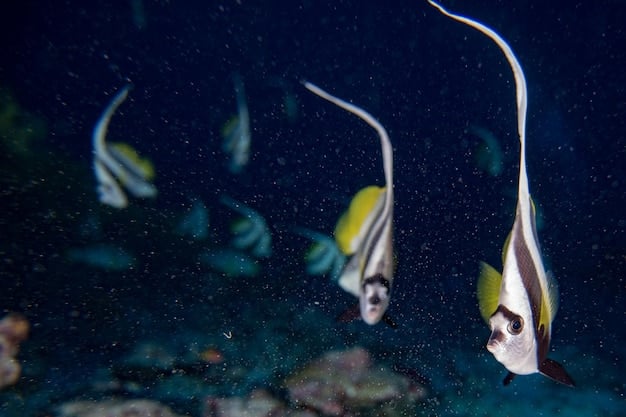New Deep-Sea Fish Discovery: Unveiling Mariana Trench Biodiversity

The discovery of a new species of deep-sea fish in the Mariana Trench highlights the extreme biodiversity found in the deepest parts of our oceans. This finding provides critical insights into the unique adaptations and ecosystems thriving under immense pressure and darkness, emphasizing the importance of deep-sea conservation efforts.
The Mariana Trench, the deepest part of the world’s oceans, continues to surprise us. Recently, the discovery of a new species of deep-sea fish has offered a remarkable glimpse into the biodiversity that thrives in this extreme environment. This discovery isn’t just about adding another name to the list of known species; it opens up new avenues for understanding how life can adapt and survive under immense pressure and in complete darkness. The story of the discovery of a new species of deep-sea fish in the Mariana Trench is a testament to the resilience and diversity of life on Earth.
Unveiling the Abyss: The Mariana Trench Ecosystem
The Mariana Trench, located in the western Pacific Ocean, is the deepest oceanic trench on Earth. Its extreme conditions, including crushing pressure and perpetual darkness, make it a challenging environment for life. Yet, it teems with unique organisms adapted to these harsh conditions. The discovery of a new species of deep-sea fish highlights just how much we still have to learn about this extraordinary ecosystem.

What Makes the Mariana Trench Unique?
The Mariana Trench presents a set of environmental factors unlike any other on our planet. Understanding these conditions is key to appreciating the adaptations of its inhabitants.
- Extreme Pressure: At its deepest point, the pressure is over 1,000 times that at sea level.
- Perpetual Darkness: Sunlight cannot penetrate these depths, leaving organisms to rely on other sources of energy.
- Cold Temperatures: The water temperature hovers just above freezing.
- Limited Food Supply: Organisms depend on marine snow, detritus sinking from the surface, or chemosynthesis.
Despite these challenges, life finds a way. The organisms that live here have evolved specific strategies to thrive. The discovery of a new species only adds to research that shows the resilience of life on Earth.
The Discovery of a New Species of Deep-Sea Fish
The identification of a previously unknown species of fish in the Mariana Trench marks a significant event in marine biology. This creature, adapted to the extreme conditions of the deep sea, provides valuable insights into evolutionary processes and biodiversity.
How Was the New Species Discovered?
The discovery was made possible through advanced research technology designed to explore extreme environments. These expeditions often involve:
- Remotely Operated Vehicles (ROVs): These are equipped with cameras and robotic arms to collect samples and record footage.
- Deep-Sea Submersibles: Manned submersibles allow scientists to directly observe and interact with the deep-sea environment.
- Advanced Imaging Technology: Special cameras capture high-resolution images and videos in low-light conditions.

The process of identifying a new species can be painstaking, involving detailed analysis of the fish’s physical characteristics, DNA, and ecological role. It’s a collaborative effort that brings together experts from various fields to piece together the puzzle of life in the deep sea.
Unique Adaptations of Deep-Sea Fish
Deep-sea fish possess a remarkable array of adaptations that allow them to survive in their extreme environment. These adaptations are crucial for thriving under immense pressure, in complete darkness, and with limited food resources. Some of the notable features include:
- Bioluminescence: Many deep-sea fish produce their own light through bioluminescence, which they use for communication, attracting prey, and evading predators.
- Specialized Sensory Organs: These fish often have enlarged eyes or other sensory organs to detect faint light or vibrations in the water.
- Low Metabolism: To conserve energy, deep-sea fish typically have a slow metabolism and reduced activity levels.
- Flexible Skeletons: Their skeletons are often made of cartilage rather than bone, allowing them to withstand the immense pressure.
The discovery of a new species in the Mariana Trench offers scientists the chance to study these adaptations. This knowledge can help us better understand the evolutionary pressures that shape life in extreme environments.
The Importance of Biodiversity in the Mariana Trench
Biodiversity, the variety of life in a particular habitat, is crucial for maintaining the health and stability of ecosystems. In the Mariana Trench, biodiversity plays a vital role in nutrient cycling, food web dynamics, and overall ecosystem resilience.
Why Does Biodiversity Matter in the Deep Sea?
The deep sea, despite its perceived remoteness, is connected to the rest of the ocean and the planet. Here’s why preserving biodiversity is important:
- Ecosystem Stability: A diverse ecosystem is better able to withstand environmental changes and disturbances.
- Nutrient Cycling: Different species play different roles in breaking down organic matter and recycling nutrients.
- Potential Discoveries: The deep sea is a treasure trove of potential resources, including new medicines and industrial enzymes.
The discovery of a new species of deep-sea fish underscores the importance of ongoing research and conservation efforts in the Mariana Trench. By studying and protecting this unique ecosystem, we can gain a better understanding of the interconnectedness of life on Earth.
Implications for Deep-Sea Conservation Efforts
Conserving the Mariana Trench and its unique biodiversity is vital for preserving one of the most extraordinary ecosystems on our planet. Protecting such a place is a global responsibily.
How Can We Protect the Mariana Trench?
Protecting the Mariana Trench requires a multifaceted approach that addresses various threats and promotes sustainable practices. These steps can include:
The discovery of a new species of deep-sea fish serves as a reminder of the hidden wonders of our oceans and the need to protect them for future generations.
| Key Point | Brief Description |
|---|---|
| 🐠 Discovery | New fish species unveils Mariana Trench biodiversity. |
| 🔬 Adaptations | Unique traits help fish survive extreme pressure and darkness. |
| 🌊 Conservation | Protecting the Trench safeguards a fragile ecosystem. |
| 💡 Research | Ongoing studies reveal more deep-sea secrets. |
Frequently Asked Questions (FAQ)
It highlights the remarkable biodiversity in extreme environments and provides crucial insights into adaptation and evolution under immense pressure and darkness.
Common adaptations include bioluminescence for communication, specialized sensory organs for detecting faint light, and flexible skeletons to withstand high pressure.
They use advanced tools such as Remotely Operated Vehicles (ROVs), deep-sea submersibles, and advanced imaging technology to capture images and collect samples.
Biodiversity helps maintain ecosystem stability, aids in nutrient cycling, and offers potential discoveries for medicine and industrial applications.
Efforts include establishing marine protected areas, regulating deep-sea mining, reducing plastic pollution, and supporting ongoing research and education initiatives.
Conclusion
The discovery of a new species of deep-sea fish in the Mariana Trench not only enriches our understanding of marine life but also underscores the critical importance of deep-sea exploration and conservation. By recognizing the unique adaptations and ecological roles of these organisms, we can better appreciate the intricate web of life that exists even in the most extreme environments.





